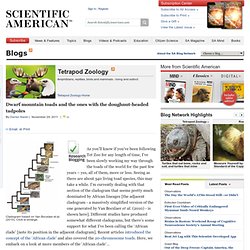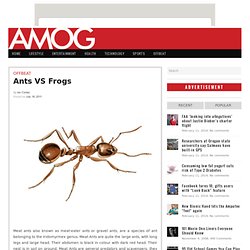

Eye of Newt. Forget Seismologists: We Should Be Using Toads to Predict Earthquakes. The Origin of the Amphibian Chytrid Fungus. The amphibian chytrid fungus (Batrachochytrium dendrobatidis: Bd) is the cause of the most spectacular loss of vertebrate biodiversity in recorded history.

To date, at least 200 species have been driven extinct and hundreds more have suffered major declines. Even amphibians within the world's best protected ecosystems have been hard-hit, including California's mountain yellow-legged frog (Rana muscosa, Rana sierrae). This amphibian pathogen appears to have emerged in just the last 50 years, subsequently spreading around the world at lightning speed. So, where did Bd come from and what allowed its recent emergence? These are questions that researchers have asked since its description in 1999. A just-published paper by Farrer et al. now advances this story even further. Another research group is using similar methods to provide an even more detailed view of the emergence of Bd as an amphibian pathogen, and will hopefully publish their results in the near future.
Salamanders Used as Fishing Bait Linked to Amphibian Disease Epidemics - Part 1. Hello, Frank Indiviglio here.

Shocking as it may be to anyone with even a passing awareness of conservation issues, tiger salamander larvae (Ambystoma tigrinum) are still widely used as fishing bait throughout much of the USA. Run through with hooks while alive, the 6-10 inch amphibians are wildly popular with anglers seeking bass, pickerel and other fishes. Disease and the Bait Trade Recently (April, 2009), biologists at the National Science Foundation announced that a significant percentage of larvae in the bait trade have tested positive for the deadly Chytrid fungus Batrachochytrium dendrobatidis. This fungus has decimated amphibian populations on nearly every continent, and is responsible for the extinctions of local populations and, most likely, entire species. Herpetologists are working feverishly to control its spread, but are as yet unable to understand why the fungus has become such a devastating problem in recent years.
Half of Europe's frogs and toads face extinction in 40 years, 'terrifying' study shows. Dwarf mountain toads and the ones with the doughnut-headed tadpoles. Cladogram based on Van Bocxlaer et al. (2010).

Click to enlarge. As you’ll know if you’ve been following Tet Zoo for any length of time, I’ve been slowly working my way through the toads of the world for the past few years – yes, all of them, more or less. Seeing as there are about 540 living toad species, this may take a while. I’m currently dealing with that section of the cladogram that seems pretty much dominated by African lineages [the adjacent cladogram - a massively simplified version of the one generated by Van Bocxlaer et al. (2010) - is shown here]. Salamander Study Enlists New York City Seventh Graders. Richard Perry/The New York Times Students from Mark Twain I.S. 239 studied salamanders on Staten Island this week.

“Don’t grab him by the tail,” warned another. Chytrid Fungus: Hope for Fighting Deadly Amphibian Disease. Researchers at Oregon State University have discovered a freshwater organism that might help in fighting the chytrid fungus, which is a principal cause for the worldwide amphibian decline.

A freshwater species of zooplankton, called Daphnia magna, could provide a tool for biological control of the deadly fungus whose impact, one researcher has called “the most spectacular loss of vertebrate biodiversity due to disease in recorded history.” Possible biological control discovered for pathogen devastating amphibians. The study this story is based on is available online: CORVALLIS, Ore. - Zoologists at Oregon State University have discovered that a freshwater species of zooplankton will eat a fungal pathogen which is devastating amphibian populations around the world.

This tiny zooplankton, called Daphnia magna, could provide a desperately needed tool for biological control of this deadly fungus, the scientists said, if field studies confirm its efficacy in a natural setting. The fungus, B. dendrobatidis, is referred to as a “chytrid” fungus, and when it reaches high levels can disrupt electrolyte balance and lead to death from cardiac arrest in its amphibian hosts. One researcher has called its impact on amphibians “the most spectacular loss of vertebrate biodiversity due to disease in recorded history.”
The research, reported today in the journal Biodiversity and Conservation, was supported by the National Science Foundation. 27 Wonderful Images of Frogs. Blog Posts by Mike Panic By Mike Panic on in Cool Photos, Featured [ 13 Comments ]

Crisis in the Amphibian World. I Confess: I'm Jealous Of Frogs, Lizards And Salamanders Because Of Their Stem Cells. The Face of a Frog: Time-Lapse Video Reveals Never-Before-Seen Bioelectric Pattern. Newswise — MEDFORD/SOMERVILLE, Mass.

--For the first time, Tufts University biologists have reported that bioelectrical signals are necessary for normal head and facial formation in an organism and have captured that process in a time-lapse video that reveals never-before-seen patterns of visible bioelectrical signals outlining where eyes, nose, mouth, and other features will appear in an embryonic tadpole. The Tufts research with accompanying video and photographs will appear July 18 online in advance of publication in the journal Developmental Dynamics. The Tufts biologists found that, before the face of a tadpole develops, bioelectrical signals (ion flux) cause groups of cells to form patterns marked by different membrane voltage and pH levels. When stained with a reporter dye, hyperpolarized (negatively charged) areas shine brightly, while other areas appear darker, creating an "electric face.
" Tufts Post Doctoral Associate Laura N. Scientific Serendipity. Rainbow toad: Found after 87 years, first photo ever. Frog Bladders Hold Surprises. Inflatable Female Toads Call the Shots. India's most wanted. A few weeks ago, Dr SD Biju, an eminent Indian amphibian researcher, was leading volunteers in the forests surrounding Mirik Lake in Darjeeling, West Bengal.

They were on the lookout for frogs belonging to that region. Here, it's not habitat destruction that has led to the frogs' disappearance, but the fact that locals comsume them. Ants VS Frogs. Meat ants also known as meat-eater ants or gravel ants, are a species of ant belonging to the Iridomyrmex genus.

Meat Ants are quite the large ants, with long legs and large head. Their abdomen is black in colour with dark red head. Their nest is in soil on ground. Meat Ants are general predators and scavengers, they also tend soft-bug, such as aphids, to collect honeydew.They can be found throughout Australia. Recently it has been found that Australian meat ants could become foot soldiers in a war against cane toads. Newts able to regenerate body parts indefinitely - life - 12 July 2011. Salamanders spell out evolution in action.
Lungless salamanders (Ensatina eschscholtzii) live in a horseshoe-shape region in California (a 'ring') which circles around the central valley. The species is an example of evolution in action because, while neighboring populations may be able to breed, the two populations at the ends of the arms of the horseshoe are effectively unable to reproduce. New research published in BioMed Central's open access journal BMC Evolutionary Biology showed that this reproductive isolation was driven by genetic divergence rather than adaption to different ecological habitats. Researchers used genetic variation to determine 20 distinct populations of salamanders and focused in detail at 13 zones where the populations were able to cross breed.
Results showed that the diversification of salamander populations was associated with significant genetic divergence, both nuclear and mitochondrial, and also with strong ecological divergence, in the plants and climate within their habitats. Frog feet could solve a sticky problem. Tree frogs have specially adapted self-cleaning feet which could have practical applications for the medical industry. “Tree frog feet may provide a design for self-cleaning sticky surfaces, which could be useful for a wide range of products especially in contaminating environments – medical bandages, tyre performance, and even long lasting adhesives,” says researcher, Niall Crawford at the University of Glasgow who will be presenting this work at the Society for Experimental Biology Annual Conference in Glasgow on 3rd of July, 2011.
Tree frogs have sticky pads on their toes that they use to cling on in difficult situations, but until now it was unclear how they prevent these pads from picking up dirt. “Interestingly the same factors that allow tree frogs to cling on also provide a self cleaning service. Breathing Life into an Extinct Species: Ancient DNA Cracks the Case. Otago Daily Times Online News Keep Up to Date Local, National New Zealand & International News. Salamander Decline Found In Central America. The decline of amphibian populations worldwide has been documented primarily in frogs, but salamander populations also appear to have plummeted, according to a new study by University of California, Berkeley, biologists.
By comparing tropical salamander populations in Central America today with results of surveys conducted between 1969 and 1978, UC Berkeley researchers have found that populations of many of the commonest salamanders have steeply declined. On the flanks of the Tajumulco volcano on the west coast of Guatemala, for example, two of the three commonest species 40 years ago have disappeared, while the third was nearly impossible to find. Smallest Andean frog discovered in cloud forests of Peru. Frogs are an important food source for people in parts of Madagascar. Mongabay.com March 23, 2009 With its famous diversity of frog species, Madagascar has long been targeted by smugglers for the pet trade. While this threat is relatively well understood, less known is the domestic market for edible frogs. Writing in Tropical Conservation Science, researchers from the University of Aberdeen and institutions in Madagascar provide a glimpse into this activity.
Richard Jenkins and Malagasy colleagues conducted a five-month survey of collectors delivering frogs to a restaurant in eastern Madagascar. They found a thriving trade — 3,233 frogs were delivered to the restaurant during the period. Income for collectors selling edible frogs was only slightly lower per edible frog ($0.29) than it was for Mantella milotympanum ($0.32), a critically endangered frog collected for the international pet trade, thus providing an importance source of income for frog hunters. Amphibians May Develop Immunity To Fatal Fungus. Amphibian populations are declining worldwide, principally because of the spread of the fungal disease chytridiomycosis.
Researchers know that some amphibian populations and species are innately more susceptible to the disease than others. PHOTOS: Rainbow Hues of Amphibian "Worms" Demystified. Dwarf In The Elfin Forests: Tiniest Frog In South America’s Andes Mountains. Tiny frogs and giant spiders: the best of friends : Tetrapod Zoology. 'Horror frog' breaks own bones to produce claws - life - 28 May 2008. Imminent extinction of Archey’s frogs « Frog Matters.
Frog Matters. Livingunderworld.org - A web project about amphibians. AmphibiaWeb. Amphibian Species of the World.